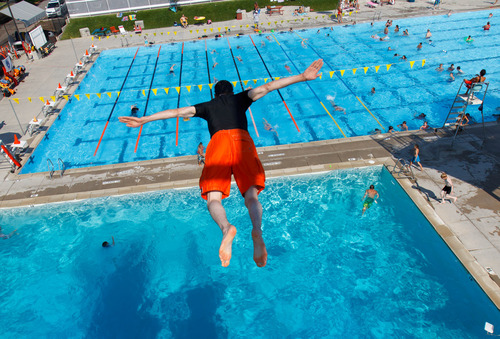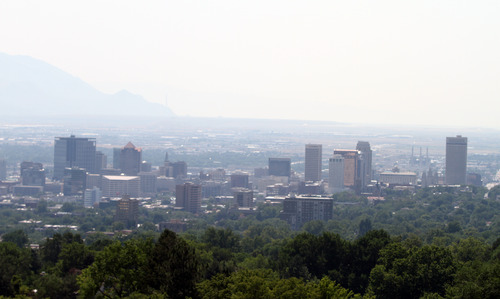This is an archived article that was published on sltrib.com in 2013, and information in the article may be outdated. It is provided only for personal research purposes and may not be reprinted.
Air-quality watchers were pleasantly surprised this week — even with downtown pollution monitors beginning to register unhealthy levels of smog.
They weren't happy that ozone pollution is creeping up.
They were delighted, though, the high levels weren't seen until July was well underway.
Normally, pollution reaches the "unhealthy" range as early as May. This year, although it's been sunny and hot, smog didn't reach unhealthy levels in the Salt Lake Valley until Tuesday.
"We've been quite fortunate," said Bo Call, who oversees air-quality monitoring for the Utah Department of Environmental Quality. "We've definitely been in a situation where we would expect the ozone to be higher."
At about 4 p.m. on Tuesday, a monitor at Hawthorne Elementary in downtown Salt Lake City maxed at 102 parts per billion of smog in the air. It was the first time this had happened in Salt Lake County all summer — despite more than a week of sunny days at or above 100 degrees.
The U.S. Environmental Protection Agency considers ozone above 75 ppb unhealthy averaged over eight hours. Looked at that way, Hawthorne readings, at 80 ppb over eight hours, topped that standard Tuesday afternoon.
Everyone expected a lot more smoggy afternoons, considering the formula for ozone pollution — exhaust from industry and vehicles + sunshine + heat.
The reason behind the trend has been discussed among those who follow the issue, including members of the Air Quality Board.
"It was a persistent surprise," said Kathy Van Dame, policy coordinator for the Wasatch Clean Air Coalition and a member of the board.
The thinking is that two big factors are behind the improvements: what state-air quality officials are doing on a day-to-day basis with their spare-the-air "action alerts" and measures taken to cut pollution emissions year-round under the Clean Air Act.
"A great deal has been accomplished," said Van Dame, who'd been tracking pollution levels in-depth for weeks and who applauded the Division of Air Quality's proactive approach to educating the public about sparing the air from unnecessary pollution.
Call agreed.
"The pollution mix out there, we think we're doing a decent job reducing it," he said. "We're on the right track."
All signs pointed to a high ozone through the workweek, and Call's office projects unhealthy air for sensitive individuals — the very young, the very old and people with heart and lung trouble — during that time.
And, while the only other county that exceeded smog limits on Tuesday was Box Elder, other counties — Duchesne, Carbon, Uintah, Utah and Weber, to be specific — had very close readings that were expected to be elevated Wednesday, too, thanks partly to the wildfire smoke drifting into the valley.
Twitter: @judyfutah —
Ozone: Safeguarding your health
To protect your health from smog, it's important to monitor how it affects you, experts agree. Generally speaking, ozone pollution increases during the hottest, sunniest parts of the day, usually between noon and 6 p.m. By limiting outdoor exercise and exertion to morning and evening, you can limit your exposure to smog's harmful impacts. For more information, go to http://www.cleanair.utah.gov/.









